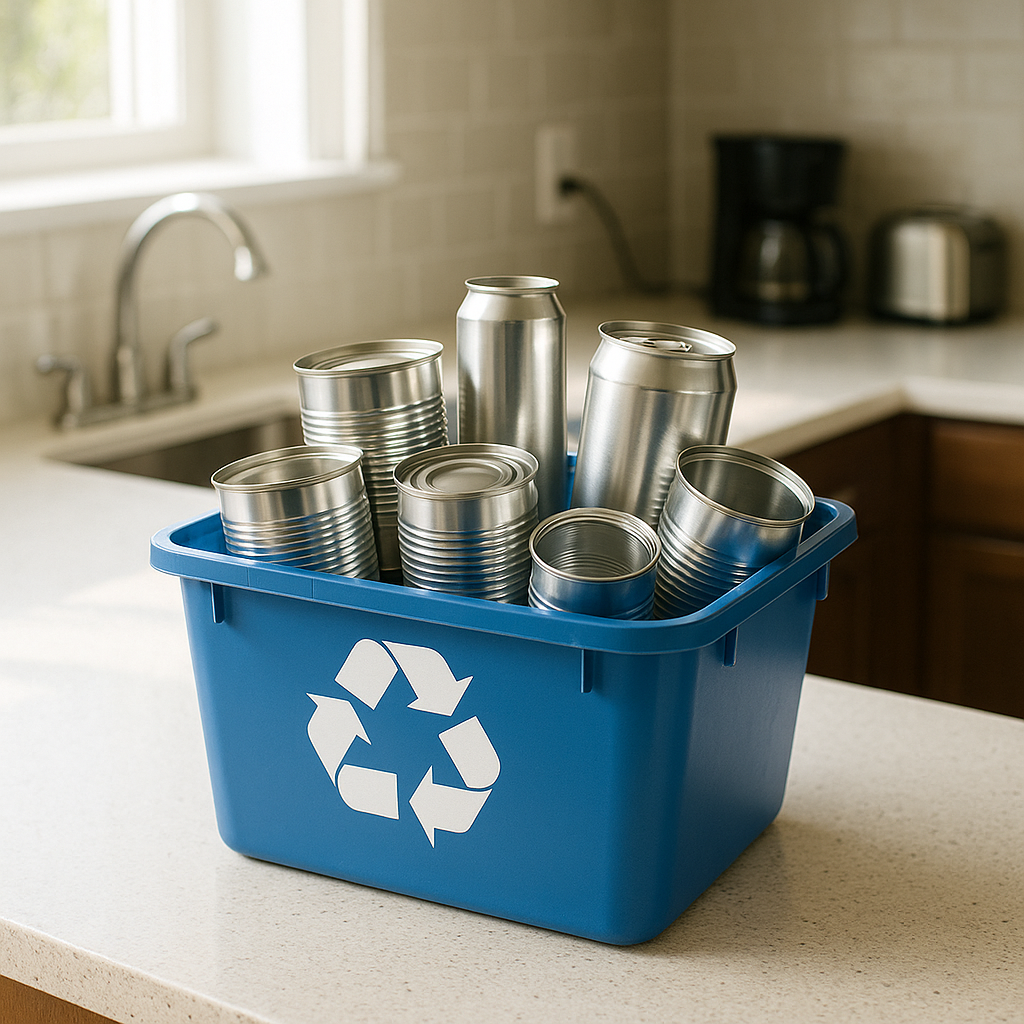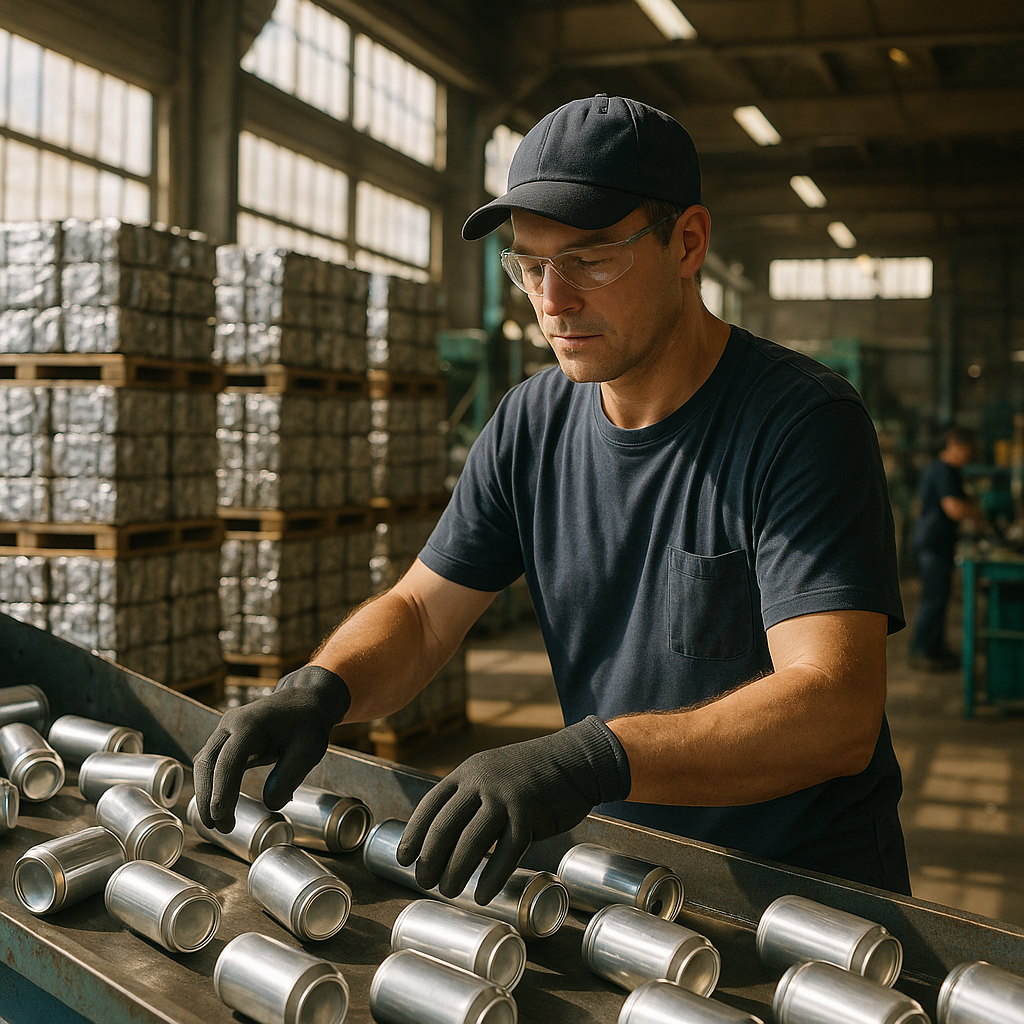5901 Botham Jean Blvd, Dallas, TX 75215
Key Aluminum Recycling Facts You Should Know
November 27, 2025Aluminum’s lifecycle showcases remarkable efficiency that stands apart from other packaging materials. A used aluminum drink can can be recycled and back on a supermarket shelf as a new can in as little as 60 days. This rapid turnaround contrasts sharply with its impact on landfills, where an unrecycled can will take 500 years to oxidize.
The recycling process begins when consumers place empty cans into recycling bins. Collection trucks transport these drink containers to materials recovery facilities where advanced sorting technology separates aluminum from other recyclables. Workers and automated systems remove any remaining labels or contaminants before the cans move to the next processing stage.
The Aluminum Can Recycling Process

Once collected and sorted, the aluminum cans undergo thorough cleaning and shredding. Facilities wash the metal pieces to remove any traces of lubricants or beverage residue. The clean aluminum fragments then enter furnaces heated to approximately 750 degrees Celsius, melting the metal completely while maintaining its structural integrity.
The molten aluminum gets poured into molds and cooled to form solid ingots. Each ingot contains material from approximately 1.5 million recycled aluminum cans. Rolling mills then press these ingots into thin sheets before machines punch out circular blanks that will become new can bodies.
Manufacturing equipment shapes these blanks through a precise drawing and ironing process. The metal gets stretched into cylindrical can bodies while maintaining wall thickness comparable to human hair. After forming, the cans receive protective coatings and printing before quality control inspections ensure they meet specifications for filling and distribution.
This closed-loop recycling system demonstrates aluminum’s infinite recyclability without material degradation. Unlike plastic containers that lose structural integrity through repeated processing, aluminum retains its original properties indefinitely. The Aluminum Association reports that approximately 75% of all aluminum ever produced remains in use today through continuous recycling cycles.
The environmental and economic benefits of aluminum can recycling extend far beyond the 60-day turnaround time. Recycling aluminum requires only 5% of the energy needed to produce new metal from bauxite ore. Globally, an average of 113,200 aluminum cans are recycled every minute of every day, preventing valuable materials from entering landfills and reducing the demand for virgin aluminum extraction.
What are the Economic Benefits of Aluminum Recycling?

The aluminum recycling industry serves as a powerful economic engine, generating substantial employment opportunities across the United States. Research shows that achieving a 90% recycling rate for aluminum cans would create approximately 104,000 new jobs in collection, sorting, and reprocessing sectors. These positions span diverse skill levels, from manual collection and processing roles to advanced manufacturing and research positions.
Beyond direct employment, the economic multiplier effect amplifies these benefits significantly. The Aluminum Association calculates that every direct job in the aluminum recycling industry supports 3.5 additional indirect jobs in related sectors including transportation, retail, and services. This multiplier effect positions recycling facilities as economic anchors in their communities, driving broader regional economic activity.
Wage growth represents another substantial economic benefit of expanded aluminum recycling. Increasing the national recycling rate to 90% would more than double total wages in the waste collection and recycling industry, jumping from $2.1 billion to $5 billion annually. This dramatic wage increase reflects both the creation of new positions and the higher-value nature of aluminum recovery operations compared to general waste management.
Material sales from aluminum recycling generate considerable economic activity, with projections showing $1.6 billion in annual economic activity through improved material recovery. The high intrinsic value of aluminum scrap drives this revenue generation, as recycled aluminum commands premium prices in commodity markets. This economic value has enabled the aluminum recycling industry to operate profitably without government mandates or subsidies.
The potential economic savings from maximizing aluminum recycling reach even greater heights. If all aluminum beverage cans in the United States were recycled, the economy could save more than $1 billion annually. Currently, the nation recycles only about 45% of aluminum cans, meaning over $800 million worth of aluminum ends up in landfills each year, representing a tremendous economic loss.
Supply chain resilience adds another layer of economic benefit, particularly as aluminum has been designated a critical material by the United States. More than 80% of U.S. aluminum production now comes from recycled sources, reducing dependence on imported primary aluminum and strengthening domestic manufacturing capabilities. This shift toward secondary aluminum production requires only about 10% of the invested capital compared to primary smelting operations, making it a more efficient use of economic resources.
The industry’s recycling efforts deliver additional economic value through energy savings equivalent to more than 90 million barrels of oil annually. These energy savings translate into reduced operational costs for manufacturers and lower consumer prices for aluminum products. The cumulative effect of these economic benefits demonstrates how aluminum recycling supports both immediate job creation and long-term economic sustainability in the circular economy.
What are the Global Recycling Rates for Aluminum?
Aluminum beverage cans achieved a global recycling rate of 75% in 2023, establishing them as the most recycled beverage container worldwide. This figure represents a significant milestone in materials recovery, surpassing both PET bottles at 47% and glass bottles at 42% according to comprehensive industry analysis. The data reflects the inherent value and circular nature of aluminum as a material.
Regional performance varies dramatically across global markets. East Asia and the Pacific region leads with an impressive 94.6% recycling rate, while Latin America and the Caribbean follows closely at 94.0%. These exceptional rates demonstrate how effective waste management systems can maximize aluminum recovery efficiency.
Brazil stands as the global exemplar for aluminum can recycling. The country has maintained a 98% recycling rate for 15 consecutive years, supported by over 800,000 collectors who participate in the recovery process. This achievement stems from aluminum’s high material value and the comprehensive collection infrastructure developed across the nation.
North American Performance Challenges
North America significantly underperforms compared to global standards, achieving only 45.3% recycling rates for aluminum cans. The United States specifically recorded a 43% recycling rate in 2023, representing the lowest point in decades despite aluminum cans maintaining the highest value among beverage containers at $1,338 per ton.
This performance gap translates to substantial economic waste. American consumers discarded approximately 61 billion aluminum cans in 2023, equivalent to 15 twelve-packs per person. The lost aluminum represents nearly $1.2 billion in material value ending up in landfills rather than supporting circular economy principles.
Industry Recycling Infrastructure
The aluminum industry recycling rate, which encompasses all used beverage containers including imports and exports, reached 57% globally. This metric indicates overall industry stewardship in managing aluminum materials through recovery systems. The closed-loop circularity rate for aluminum cans achieved 96.7%, far exceeding PET bottles at 34% and glass bottles between 30-60%.
Recycled content in aluminum cans averages 71% globally, though this varies by manufacturing location. This recycled content consists of 53% post-consumer scrap, primarily from used beverage containers, 18% post-industrial scrap, and 29% primary aluminum. The infinite recyclability of aluminum enables this high recycled content without material degradation.
Policy Impact on Recycling Efficiency
Deposit return systems demonstrate proven effectiveness in improving aluminum recovery rates. States with recycling refund programs achieve average aluminum can recycling rates of 68% compared to 22% in states without such policies. This 46 percentage point difference highlights how policy frameworks directly influence recycling efficiency and material recovery outcomes.
International statistics reveal that recycling infrastructure and policy coordination remain critical factors. Countries with comprehensive waste management systems and extended producer responsibility programs consistently achieve higher aluminum recovery rates than regions relying solely on voluntary collection efforts.
Conclusion: The Lasting Impact of Aluminum Recycling

The facts are clear: aluminum recycling offers profound and lasting benefits. From saving 95% of the energy needed for production to drastically reducing greenhouse gas emissions and bolstering the economy, its impact is undeniable. As an infinitely recyclable material, aluminum is a perfect example of a sustainable resource that supports a circular economy, proving that a small act like recycling a can has a massive collective payoff.
The environmental and economic advantages of aluminum recycling extend far beyond individual actions. With 75% of all aluminum ever produced still in circulation today, this “forever metal” demonstrates how effective recycling programs can transform waste into valuable resources while creating jobs and reducing our dependence on raw materials. For comprehensive recycling solutions that maximize both environmental impact and economic value, contact Okon Recycling at 214-717-4083.
